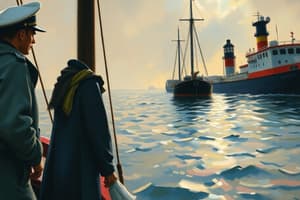Podcast
Questions and Answers
Maritime safety refers to the policies, regulations, and practices aimed at preventing accidents, injuries, and fatalities at ______, as well as protecting the marine environment.
Maritime safety refers to the policies, regulations, and practices aimed at preventing accidents, injuries, and fatalities at ______, as well as protecting the marine environment.
sea
The International Maritime Organization (IMO) is the primary agency responsible for developing and implementing global ______ safety standards.
The International Maritime Organization (IMO) is the primary agency responsible for developing and implementing global ______ safety standards.
maritime
The International Convention for the Safety of Life at ______ is a key treaty that sets minimum safety standards for ships.
The International Convention for the Safety of Life at ______ is a key treaty that sets minimum safety standards for ships.
Sea
Life-saving appliances include ______ and emergency beacons.
Life-saving appliances include ______ and emergency beacons.
Fire protection measures include ______ equipment and fire-resistant materials.
Fire protection measures include ______ equipment and fire-resistant materials.
The International Convention on Load Lines (LL) sets minimum safety standards for ship ______ and construction.
The International Convention on Load Lines (LL) sets minimum safety standards for ship ______ and construction.
The Maritime Labour Convention (MLC) sets minimum safety and health standards for ______.
The Maritime Labour Convention (MLC) sets minimum safety and health standards for ______.
A safety management system (SMS) is a structured approach to managing ______ risks and ensuring compliance with safety regulations.
A safety management system (SMS) is a structured approach to managing ______ risks and ensuring compliance with safety regulations.
Human error is a leading cause of ______ accidents.
Human error is a leading cause of ______ accidents.
SMS typically includes safety policies and ______.
SMS typically includes safety policies and ______.
Flashcards are hidden until you start studying
Study Notes
Maritime Safety Overview
Maritime safety refers to the policies, regulations, and practices aimed at preventing accidents, injuries, and fatalities at sea, as well as protecting the marine environment.
International Maritime Safety Regulations
- The International Maritime Organization (IMO) is the primary agency responsible for developing and implementing global maritime safety standards.
- The International Convention for the Safety of Life at Sea (SOLAS) is a key treaty that sets minimum safety standards for ships, including those related to life-saving appliances, fire protection, and navigation.
Safety of Life at Sea (SOLAS) Requirements
- Life-saving appliances:
- Life rafts and emergency beacons
- Life jackets and personal flotation devices
- Fire protection:
- Firefighting equipment and fire-resistant materials
- Fire drills and training
- Navigation:
- Navigation equipment and charts
- Bridge design and navigation procedures
Other Maritime Safety Regulations
- The International Convention on Load Lines (LL) sets minimum safety standards for ship design and construction.
- The Maritime Labour Convention (MLC) sets minimum safety and health standards for seafarers.
- The International Safety Management (ISM) Code provides guidelines for safe ship operation and pollution prevention.
Safety Management Systems
- A safety management system (SMS) is a structured approach to managing safety risks and ensuring compliance with safety regulations.
- SMS typically includes:
- Safety policies and procedures
- Risk assessment and management
- Training and drills
- Incident reporting and investigation
Human Factors in Maritime Safety
- Human error is a leading cause of maritime accidents.
- Factors contributing to human error include:
- Fatigue and sleep deprivation
- Inadequate training and experience
- Poor communication and teamwork
- Distractions and complacency
Technology and Maritime Safety
- Advances in technology have improved maritime safety, including:
- Electronic navigation aids (e.g., GPS, ECDIS)
- Safety monitoring and surveillance systems
- Automation and remote control systems
- Improved communication systems (e.g., satellite communication, AIS)
Maritime Safety Overview
- Maritime safety aims to prevent accidents, injuries, and fatalities at sea, and protect the marine environment.
International Maritime Safety Regulations
- International Maritime Organization (IMO) is the primary agency responsible for global maritime safety standards.
- International Convention for the Safety of Life at Sea (SOLAS) sets minimum safety standards for ships, including life-saving appliances, fire protection, and navigation.
Safety of Life at Sea (SOLAS) Requirements
- Life-saving appliances:
- Life rafts and emergency beacons
- Life jackets and personal flotation devices
- Fire protection:
- Firefighting equipment and fire-resistant materials
- Fire drills and training
- Navigation:
- Navigation equipment and charts
- Bridge design and navigation procedures
Other Maritime Safety Regulations
- International Convention on Load Lines (LL) sets minimum safety standards for ship design and construction.
- Maritime Labour Convention (MLC) sets minimum safety and health standards for seafarers.
- International Safety Management (ISM) Code provides guidelines for safe ship operation and pollution prevention.
Safety Management Systems
- A safety management system (SMS) is a structured approach to managing safety risks and ensuring compliance with safety regulations.
- SMS typically includes:
- Safety policies and procedures
- Risk assessment and management
- Training and drills
- Incident reporting and investigation
Human Factors in Maritime Safety
- Human error is a leading cause of maritime accidents.
- Factors contributing to human error include:
- Fatigue and sleep deprivation
- Inadequate training and experience
- Poor communication and teamwork
- Distractions and complacency
Technology and Maritime Safety
- Advances in technology have improved maritime safety, including:
- Electronic navigation aids (e.g., GPS, ECDIS)
- Safety monitoring and surveillance systems
- Automation and remote control systems
- Improved communication systems (e.g., satellite communication, AIS)
Studying That Suits You
Use AI to generate personalized quizzes and flashcards to suit your learning preferences.




